A cowshed, a feed store and a fodder farm are some of the things the eyes pick out as one enters Simon Njeru’s dairy farm in Kathunire village in Embu County.

Seeds of Gold team finds two workers on the farm located some 20 minutes from Embu highway preparing to chop a heap of napier grass into tiny pieces using a chaff cutter.
“Welcome to Siria Dairy Farm,” says a happy Njeru as he leads us to a footbath where we disinfect our feet.
He started the farm in 2009, keeping one cow that would produce six litres of milk for his family. But he has since gone commercial.
Njeru’s one-and-a-half-acre farm hosts 19 Friesian cattle, eight of which are milked currently producing 160 litres a day.
“The highest milker produces 38 litres a day while the lowest eight,” he says.

He has grouped the animals according to their ages and stages of production for better handling and management.
“It takes patience and perseverance to grow such a farm. My first cow produced six litres, then moved to 15 when it calved and 21 after I got training on dairy management. This gave me the confidence to expand the farm,” he says.
Njeru sells the milk at Mburugu Dairy Cooperative Society in Embu town, with the outfit also offering farmers training and extension services in collaboration with Heifer International under the Kenya Market Led Dairy Supply Chain Project (Kemdap) reference farm initiative.
The farmers are trained on clean milk production, farm profitability, use of milking cans to transport milk, fodder farming, and animal husbandry and management. The initiative targeted to train farmers and extension workers on the best practices that will improve milk production by using model farms as the hub to share experience.
“I have learnt how to produce more milk through quality feeding and maintaining high standards of hygiene that cases of mastitis are now rare on my farm,” says Njeru, who grows napier on an acre and maize for silage on three.
The cooperative pays Sh43 for a litre of milk when he delivers to its collection centre and Sh41 when it collects from his farm. The cows are milked three times a day.
Workers milking cows at Simon Njeru’s dairy farm in Kathunire village in Embu County.
So far, so good for the farmer. However, before getting the training through the Kemdap project since 2019, Njeru struggled with diarrhoea in his herd due to poor feeds.
“But the feed processing plant at our cooperative society courtesy of Heifer International has not only enabled us to get feeds we can trust but also affordably. We pay for them from our milk deliveries,” he says, noting farmers used to rely on supplies from Thika, which were unreliable.
To complement the training he gets from Heifer International, Njeru watches plenty of YouTube videos on dairy farming and reads agriculture books.
“I have learnt about manure scoring, which is an indicator of the quality of feed a cow takes. It is scored on a one to five basis where a score of one means it is very fluid while five is dry and segmented. Through this, a farmer knows the quality of feeds they need to include or remove in a cow’s diet. Farmers should always pay attention to their animals, how they are feeding or chewing cud,” he adds.
All his 19 cows have tags on their ears that make it easier for identification and record-keeping.
“We keep track of their ages, weight, last calving and the number of calves, artificial insemination occurrences, cycling activity and pregnancy checks. This helps us in breeding.”
He feeds his animals three times a day with a mixture of hay, napier, and maize silage, with mature animals getting at least 10-15 kilos of silage made from maize depending on their body size. The feeding is adjusted accordingly for calves.
His reference farm is flocked by farmers from the county and other parts of the country for training.
“They come we share knowledge and experiences on how to ensure consistent milk production in the event of drought,” he says.
Agnes Kavatha, the project manager, Kemdap notes that reference farms have helped farmers pick lessons that aid in milk production which in turn has contributed to an increase in household income among farmers.









































